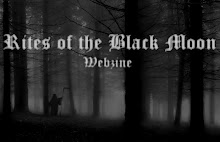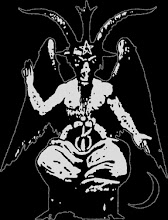
By 2001, Deathspell Omega has only released a demo and one full-length (which actually contained only four new songs, with the rest taken from the demo). Clandestine Blaze had two albums already, though the first one was of lower quality than most demos. The point being that neither band was as established as they would become. As a result of this, as well as the fact that Mikko seemed to be pretty well acquainted with Shaxul and Hasjarl, they decided to release a split album through Mikko's label, Northern Heritage. Neither band had truly realized their own styles, fully, and it is doubtful that either knew that they would later combine their sounds to create a new identity for Deathspell Omega. At any rate, the songs here are fairly strong, though not the most impressive of either band's career.
Side A features Clandestine Blaze, starting with "Will To Kill". This lengthy song takes a minute or so to really get going, presumably in an effort to create a dark atmosphere. Once it gets going, it is the standard fast style in the vein of early Darkthrone, complete with blasting drums and tremolo riffs. The sound is better than that found on their first album, though it doesn't seem to be at the same level as Night of the Unholy Flames, though it's not far off. His vocals, as usual, are a bit deeper than one might expect from this kind of music, which may help in differentiating it from some of the bands being emulated. While Clandestine Blaze would go on to forge their own identity, while still maintaining this sound at their core, this was still developing by this point. An additional lead melody, near the end, brings more life to the song but doesn't last very long.
"Blasphemous Lust" is pure Hellhammer / Celtic Frost worship. One has to wonder if Mikko was actually so much a fan of these bands or if this is simply a continuation of his tribute to Darkthrone, perhaps being ignorant to the fact that they had taken this sound from the aforementioned bands. Either way, it's quite boring. Almost all of the Hellhammer-influenced songs from Clandestine Blaze are tiresome and far too derivative of the original to warrant its inclusion on the album.
The next song is another short one, though it's far superior. "Raping the Innocent" features a very clean-sounding tremolo riff (that seems to have had some distortion added after the fact). As the song really gets going, the riff changes and the listener is left somewhat disappointed. A couple minutes later, the more interesting melody returns. However, it is ephemeral. It is always frustrating when a musician drops something that has a lot of potential in favour of less-inspired riffs.
"Genocide Operation" is the longest song on the split, clocking in over eight and a half minutes. It is also the best of the Clandestine Blaze tracks. This one reminds one of Burzum, with the slow pace and the style of riffing. It has a very cold and mournful atmosphere, with additional notes flowing through to increase the sense of despondency. This epic composition may be one of the more ambitious efforts from this point in Clandestine Blaze's career. It is very minimalist and primitive, yet it manages to create quite a dreary feeling. It leaves you feeling drained of all energy, simply waiting for your inevitable death. As the cold hand rips into your chest and takes your weakened heart within its icy grip, you have neither the will nor the desire to resist.
Side B features Deathspell Omega, and they waste no time in getting started with "Bestial Orgies". In total contrast to the atmospheric song that ended Side A, the band unleashes cold tremolo riffs, semi-fast drumming and raspier vocals that are more suitable to the music. The drums actually sound real, as opposed to those on Infernal Battles, so this is already an improvement. The guitars possess a sharp sound, but not nearly as raw as the old Darkthrone albums that they are hoping to recreate. With this first song, the band displays that they have improved quite a bit in the time since their debut album was released.
"The Suicide Curse" is the highlight of Side B. It begins with a very clear tremolo riff that appears to be the focus of the song, above vocals or drums. This is a very good thing, as the guitar riffs should always come first. The style employed here is almost reminiscent of Hirilorn, the previous band of Shaxul and Hasjarl, in the sense that the lead melodies are very clean-sounding. As the song progresses, the pace slows down and there are some open-arpeggio riffs that add depth to the atmosphere, hearkening back to the old Burzum albums. However, the feeling is quite different here. The song then speeds up again, utilizing a different tremolo riff but maintaining the high tension. This transitions back into the first riff, which is utterly brilliant. Regardless of whether or not it's based on some earlier work of Darkthrone or Gorgoroth, this is pulled off very well.
The split ends with "Seal of Perversion". It appears that the songs should have been placed in a different order, as this can in no way compete with the previous song. It's solid enough, surely, but very few songs could have successfully followed "The Suicide Curse". This one is, again, in the Transilvanian Hunger vein, consisting of blasting drums and tremolo riffs. There is definitely a chaotic feeling that runs through Deathspell Omega's work, yet it's always very cohesive. Mid-way through the song, the pace slows down a bit and becomes oddly catchy. It then returns to the previous tempo. The song, probably, goes a little longer than it should; it might have had a stronger impact if it had been more concise. However, there are no serious complaints other than the poor placement of this song. It feels anti-climactic when following something of such high quality.
All in all, this release displays the further development of these two bands, with Deathspell Omega showing marked improvement over their previous output. This is a worthy purchase for fans of either band.
.jpg)


